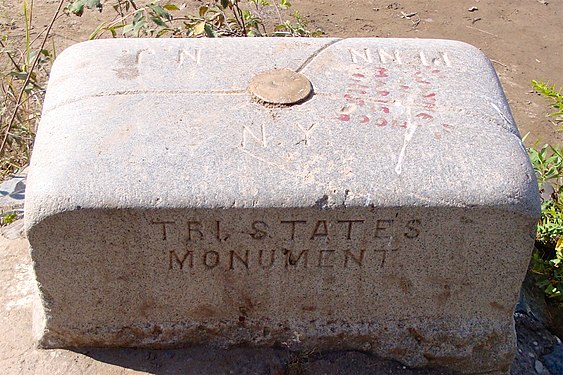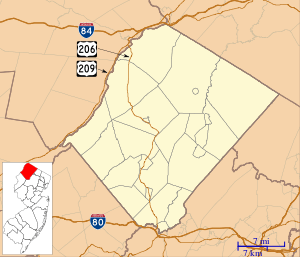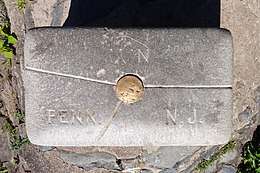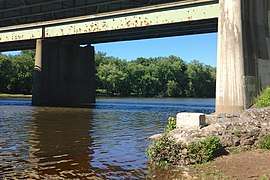Tri-States Monument
The Tri-States Monument (also known as Tri-State Rock) is a granite monument that marks the tripoint of the state boundaries of New Jersey, New York, and Pennsylvania. It is at the northwestern end of the boundary between New Jersey and New York, the northern end of the boundary between New Jersey and Pennsylvania, and the eastern end of the boundary between New York and Pennsylvania. The monument is located at the confluence of the Delaware and Neversink rivers.[1][2][3][4] This location is also known as Carpenter's Point.[5]
 Tri-States Monument, 2009 | |
 Location in Sussex County, New Jersey  Tri-States Monument (New Jersey)  Tri-States Monument (the United States) | |
| Coordinates | 41°21′26.1849″N 74°41′41.0032″W |
|---|---|
| Location | Tripoint for the states of New Jersey, New York, and Pennsylvania |
| Material | Granite |
The nearby Witness Monument, also known as the Reference Monument or the western State Line Monument, is a taller upright granite monument located south of the Laurel Grove Cemetery in Port Jervis, New York, and under a bridge for Interstate 84. It is not directly on any state boundary, but instead witnesses the location of two points: this tripoint and the corner boundary point between New York and Pennsylvania in the Delaware River.[1]
The Supreme Court of the United States summarized the boundaries of these three states with respect to this monument in New Jersey v. New York, 283 U.S. 336 (1931):[6]
... where it (the Delaware) forms a boundary between New York and Pennsylvania. The Delaware continues its course as such boundary to Tristate Rock, near Port Jervis in New York, at which point Pennsylvania and New York are met by New Jersey. From there the river marks the boundary between Pennsylvania and New Jersey until Pennsylvania stops at the Delaware state line, and from then on the river divides Delaware from New Jersey until it reaches the Atlantic between Cape Henlopen and Cape May.
Also, it is the northernmost point of New Jersey, in Montague Township, Sussex County.[7]
Background
In 1664, King Charles II of England granted his brother, James, the Duke of York, a Royal colony that covered what had been New Netherlands. Later in 1664, the Duke of York divided this area between the Hudson River and the Delaware River to Sir George Carteret and Lord Berkeley of Stratton. The western and northern border was to be:[8][9]
along said River or Bay (the Delaware) to the northward as far as the northward most branch of the said Bay or River, which is in latitude 41 degrees, 40 minutes and crosseth over thence in a straight line to the latitude 41 degrees on Hudson's River: which said tract of land is hereafter to be called by the name of New Caeserea or New Jersey.
History
In December 1872, the New Jersey Geological Survey had the State Geologist, George H. Cook, survey the boundary between New Jersey and New York.[10] In 1874, the U.S. Coast and Geodetic Survey recovered the previous crow foot cut marking the station location and placed a lead-filled copper pipe in a deep hole drilled into the bedrock. In 1882, this copper bolt was replaced with a granite monument similar to the witness monument. But ice flows broke off the upper portion by the spring of 1883. The remaining monument was then reworked on May 21, 1885 to its current description.[11]
Description

The Tri-States Monument is 2 feet 4 inches (71 cm) long, 1 foot 4 inches (41 cm) wide, and 1 foot 5 inches (43 cm) high above the bedrock. The top surface is engraved with the initials of the names of the three states and with grooves representing the state boundaries. "Tri States Monument" is engraved on the north side. It is by the water's edge near the high-water mark of the rivers.[11] A bronze U.S. National Geodetic Survey survey marker stamped LAUREL NO. 2 1942 was in the center of the top surface until 2013.[12] It was a reference mark for the triangulation station, LAUREL, that was 25 feet (7.6 m) from the Witness Monument. Both were set in 1942.[13]


The Witness Monument is inscribed "Boundary Monument" and dated 1882 on both sides. "Witness Monument" is engraved on the east side. The New Jersey (south) side details the location of the tripoint:
South 64 degrees W. 72 1/4 feet from this is the Tri State Rock which is the northwest end of the New York & New Jersey Boundary & the north end of the New Jersey & Pennsylvania Boundary.
It also lists the commissioners from New Jersey: Abraham Browning, Thomas N. McCarter, and George H. Cook; and surveyor Edward A. Bowser. The New York (north) side details the location of the corner boundary point between New York and Pennsylvania:
The corner between New York & Pennsylvania is in the centre of the Delaware River 475 feet due west of the Tri State Rock.
And lists the commissioners from New York: Henry R. Pierson, Chauncey M. Depew, Elias W. Leavenworth; and surveyor H. W. Clarke.[14]
Gallery
 Overlooking the Tri-States Monument and the Delaware River from the Witness Monument
Overlooking the Tri-States Monument and the Delaware River from the Witness Monument Looking southwest along the Delaware River, with Sussex County, New Jersey on the left and Pike County, Pennsylvania on the right
Looking southwest along the Delaware River, with Sussex County, New Jersey on the left and Pike County, Pennsylvania on the right Looking north under the Interstate 84 bridge and along the Delaware River toward Matamoras, Pennsylvania
Looking north under the Interstate 84 bridge and along the Delaware River toward Matamoras, Pennsylvania.jpg) Postcard view
Postcard view%2C_NJ-NY-PA_Tri-States_Monument_detail.jpg) Topographic map showing state boundaries
Topographic map showing state boundaries
See also
References
- Graff, Bill (Summer 2006). "Sentinels at the Northern Border" (PDF). Unearthing New Jersey. New Jersey Geological Survey. 2 (2): 1–3.
Tri-States Monument ... this small granite slab serves as both the northern end of our boundary with Pennsylvania and the northwestern end with New York.
- "The Laws Of New York. Article 2: State Boundaries. Section 6: Pennsylvania boundary line". New York State Senate.
thence down the center of the Delaware river about eighty-five miles to its junction with the Neversink river; each of the states of New York and Pennsylvania having concurrent jurisdiction within and upon the waters of that portion of the main channel of the Delaware river between the lines of low water at either bank thereof; then S. 51° E. on prolongation of boundary line between New York and New Jersey, to "tri-state monument," set in 1882 by joint commission
- "The Laws Of New York. Article 2: State Boundaries. Section 7: New Jersey boundary line". New York State Senate.
Commencing at the said "tri-state monument," and running thence along the line laid out by a joint commission from the states of New York and New Jersey in 1774, and which was more definitely marked with monuments by another joint commission in 1882,
- "Act No. 245 of 1887: Boundary Between Pennsylvania and Other States Confirmed". Pennsylvania General Assembly. June 6, 1887.
The channel of the Delaware river, from a line drawn across said channel, from a granite monument erected upon the eastern bank of said river in the year one thousand eight hundred and eighty-two, by the joint boundary commission of the States of New Jersey and New York to mark the western extremity of the boundary line between said States of New Jersey and New York, in a westerly prolongation of said boundary line up and along said channel of said Delaware river
- Ruttenber, E. M.; Clark, L. H. (1881). "Tri-States Rock". History of Orange County, New York. Philadelphia: Everts & Peck. p. 739.
- "New Jersey v. New York, 283 U.S. 336 (1931)". Justia.
- Vermeule, C. Clarkson (1888). "Geographical Position". In Cook, George H. (ed.). Final Report of the State Geologist. 1. Trenton, New Jersey: Geological Survey of New Jersey. p. 39.
The northernmost point of the State is the Tri-States rock, at the forks of the Delaware and Navesink rivers, just south of Port Jervis, New York.
- Van Zandt, Franklin K. (1976). "New York". Boundaries of the United States and the several States. Washington, D.C.: U.S. Government Publishing Office. pp. 74–78. OCLC 69426475.
- Van Zandt, Franklin K. (1976). "New Jersey". Boundaries of the United States and the several States. Washington, D.C.: U.S. Government Publishing Office. pp. 79–80. OCLC 69426475.
- Cook, George H. (1874). Report on a Survey of the Boundary Line between New Jersey and New York, Made in July and August, 1874. New Brunswick, New Jersey: Geological Survey of New Jersey. p. 5. OCLC 77578350.
- Bailey, George I.; Hopper, Charles (1891). "Joint Report on the Examination of the Monuments Marking the Boundary Line Between the States of New York and New Jersey". In Bogart, John (ed.). Annual Report of the State Engineer and Surveyor. Albany, New York. pp. 365–6.
- "LY2604: TRI STATES". U.S. National Geodetic Survey.
- "LY2611: LAUREL". U.S. National Geodetic Survey.
- Vermeule, C. Clarkson (1888). "Physical Description of New Jersey: Northern Boundary Between New Jersey and New York". In Cook, George H. (ed.). Final Report of the State Geologist. 1. Trenton, New Jersey: Geological Survey of New Jersey. pp. 66–67.
External links
